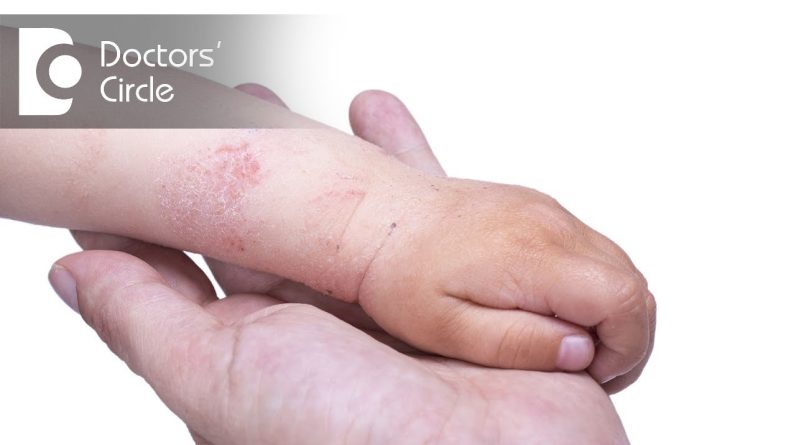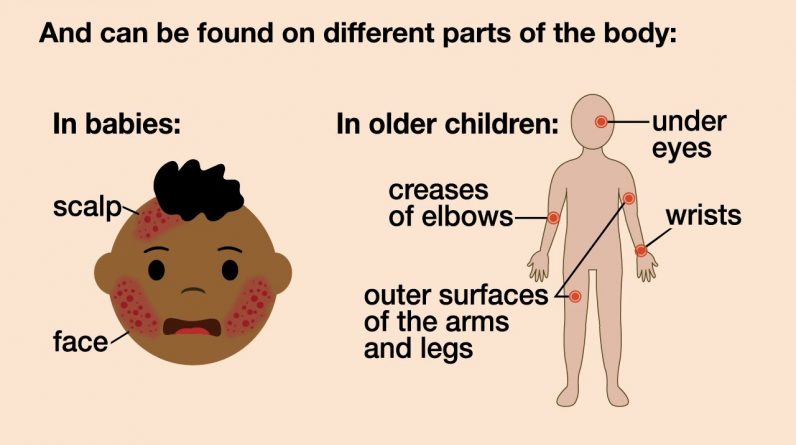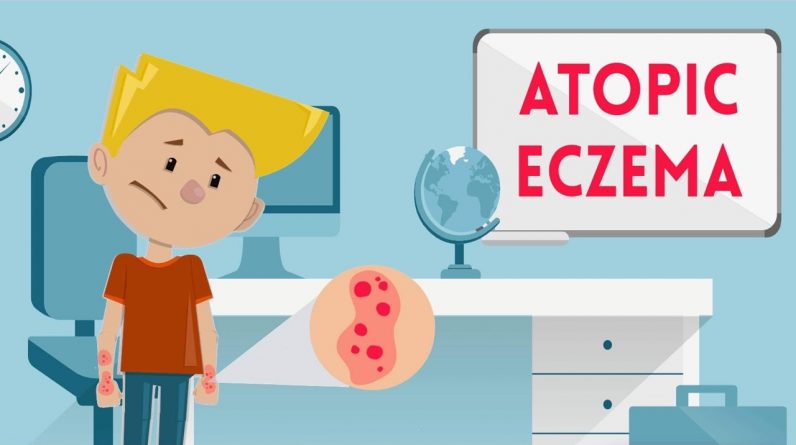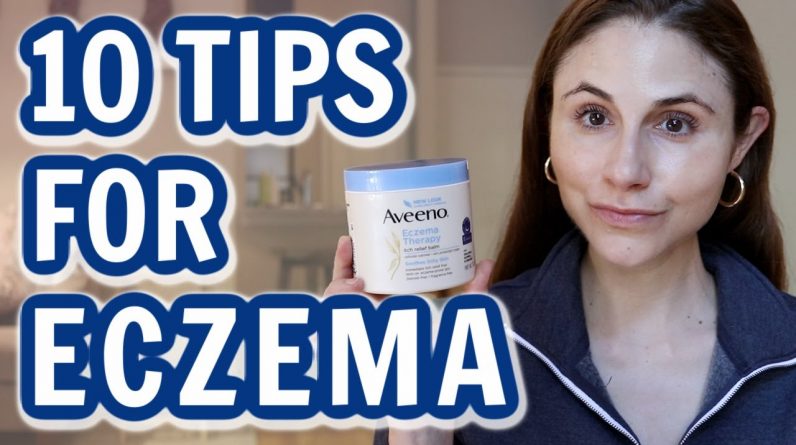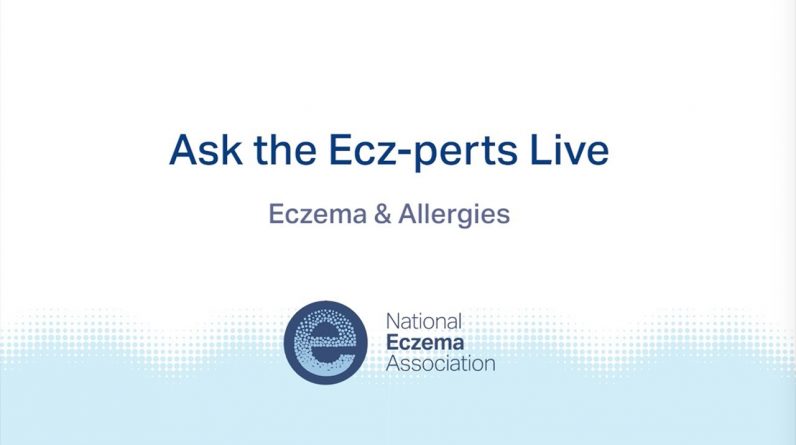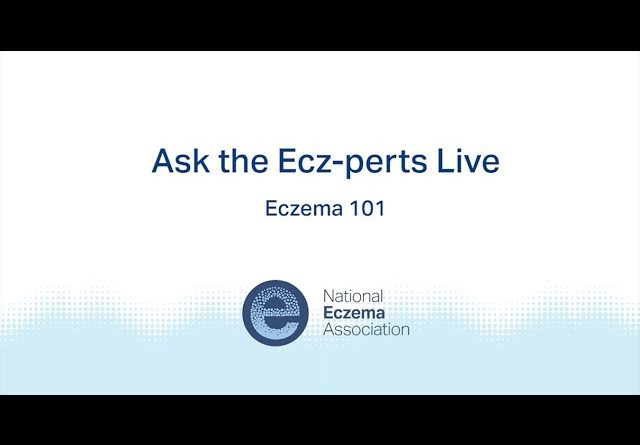Atopic Dermatitis (Eczema). Atopic dermatitis is a chronic autoimmune skin inflammatory characterized by pruritic skin lesions in areas of the body.
Atopic dermatitis is a chronic, autoimmune skin inflammatory characterized by pruritic skin lesions in areas of the body.
Hey everyone. This lesson is on atopic dermatitis, otherwise known as eczema. So – and this is where I talked about. What atopic dermatitis is that we’re gonna also going to talk about the atopic triad.
We’re. Also gonna discuss the risk factors for this condition. We’re, also going to talk about how we can make the diagnosis and what we can do to treat it. So atopic dermatitis is a chronic autoimmune, terrific inflammatory skin condition.
So those are three or four very key words to remember it:’s, chronic it’s; autoimmune, it’s pure etic, and it’s. Inflammatory again, this condition is also called eczema and it’s so prevalent that approximately 5 to 20 percent of children worldwide are affected with this condition, and it often has an onset during childhood as well.
Now atopic dermatitis, for whatever reason, has a predilection for affecting skin creases and flexure surfaces. So key points again from this are that it’s. Chronic autoimmune, pure etic, inflammatory skin condition, and it affects the skin, creases and flexure surfaces.
So atopic dermatitis is associated with other conditions as well. We call this the atopic triad and the atopic triad is the associated conditions. That start with a letter A and they all have an association with increased levels of immunoglobulin E.
Now the a topic try conditions include atopic dermatitis, allergic rhinitis and asthma and atopic dermatitis is associated strongly with allergic rhinitis and asthma and it’s been estimated that approximately 80 % of individuals with atopic dermatitis will develop either allergic rhinitis or asthma, or Both and the other, a condition that I like to kind of keep in mind as well is other allergies or other allergic reactions.
Atopic dermatitis and food allergies
Atopic dermatitis patients have a predilection for having food induced allergic reactions like or to Carius, so approximately 10 to 20 percent will have some issues with allergies to foods as well and having a very early onset of atopic dermatitis within the first three months of life is Associated with other specific allergies to foods like egg milk and peanuts, so these are just some key things to take from the slide and things to remember so what causes atopic dermatitis in the first place, so the pathogenesis of atopic dermatitis involves two separate categories.
The first is a defective epidermal barrier, so this makes sense. Atopic dermatitis is an issue with the skin, and this is a epidermal barrier. Is your skin, so it’s, something that is defective with this.
It’s actually related to a protein known as pellagra and with regards to atopic dermatitis. Often cases will have a flagrant deficiency and there are also some issues with protease anti protease activity imbalance.
There are some issues with the proteins Calla cream and le kti, and there are also some tight Junction abnormalities in the skin as well. These all can lead to a defective epidermal barrier. The second main category of pathogenesis is an immune dysregulation again, this makes sense.
Autoimmune condition
We talked about it before it’s, an autoimmune condition, so there are, will break down the immune dysregulation into an eight immune system in adaptive immune system. With regards to the innate immune system, there are reduced, tlr-2 and tr9 function and with regards the adaptive immune system, there is actually increased expression of th2 th17 and th 22 cytokines.
So these are the two main areas where the pathogenesis of atopic dermatitis begins: defective epidermal barrier and then there’s. Also, this immune component, these don’t all have to happen to have atopic dermatitis, but they’re.
All related, and they’re, all associated with thought, with the onset and the symptomatology of atopic dermatitis. So we ‘ Ve talked about the pathogenesis of atopic dermatitis, but what are some of the triggers and what are some of the risk factors and what are some of the protective factors against atopic dermatitis? So we’re, going to look at the in wincing factors.
First, the first one I want to talk about is family history. This is a generally a pretty big risk factor. Generally speaking, approximately 70 % of individuals with atopic dermatitis have a positive family history.
If you have one parent, you have a certain percentage risk and if you have two parents even have a higher risk of having atopic dermatitis. The second one is associated with the family history again: genetics.
If there’s, a loss-of-function mutation of the filet Gruden gene, we talked about earlier, this has a pretty strong, pretty strong risk of having atopic dermatitis. Also having allergies. Again, we talked about the atopic.
Turbit atopic try it. We also talked about associated allergies. If you do have allergies there, because of the associations, you’re more likely to have atopic dermatitis as well or develop it. Fourth, one is quite interesting and this one is actually environmental water sources.
So there has been some evidence to show that having the hardness and so minerals and those types of things in water can actually worsen or be a trigger for atopic dermatitis and, generally speaking, we talk about calcium carbonate.
We talk about the hardness of the environmental water source and the protective factor, so we ‘ Ve talked about the influencing factors. Now the protective factors are the following. The first one is early dig here.
So if you get your child in daycare early on in life, this seems to be protective against developing atopic dermatitis. Again, you’re getting into an environment where you’re sharing a lot of germs. You’re.
Getting a you’re, getting exposure to a lot of a lot of allergens, those types of things that can actually be helpful for protecting against atopic dermatitis. The second one is exposure to pets, so having pets can actually help reduce your risk for atopic dermatitis and the third one is actually exposure to fire animals.
This all leads into the same type of thing. You’re, getting exposed to different types of allergens and you’re generally, a training immune system to be less of that immune dysregulation. We talked about earlier, and this leads into the hygiene hypothesis in in that having a very controlled hygienic environment can actually increase the risk of having allergies and associated conditions like atopic dermatitis.
Atopic Dermatitis signs
Atopic dermatitis can have characters whose skin findings that we call atopic stigmata, and these can include keratosis, pilaris or hyper keratosis pilaris. This is colloquially called chicken skin. So it’s.
Essentially, a little raised red dots that can develop on different parts of the body. You can also see what we call Denny Morgan fold, so you can see here in this image this wrinkling effect and some some change in the skin color as well.
Underneath the eyes can also get what we call her tog G’s sign. I know I’m, not pronouncing this properly, but it’s either her toe G’s or her togs sign, and this is essentially a absence or thinning of the lateral eyebrow.
So you can see in this image here. Another skin finding is what we call pityriasis Elba Pitt arises. Elba is essentially a whitening of the skin, color or skin tone in certain parts of the body, as you can see in this image on this patients face.
So what happens generally is that if you have atopic dermatitis or eczema in certain parts of the body for a long time can actually cause scarring of that that skin and it leads to a whitened or a lighter skin tone or skin color.
So that is pityriasis Alba another one is Palmer, hyper linearity. So if you were to look at a patient’s hand, you can essentially see way more Palmer lines on their hand, and this is what we call Palmer hyper linearity.
This is a this. Could be a skin finding in atopic dermatitis and another one is something we call retro auricular fishery, so retro auricular fishing retro behind auricular with regards to the ear so behind the ear you get this fishery.
So if you were to pull back on your ear and look behind your ear, you can see this kind of almost like a chafing or a scarring, a type of fact, and this is again associated with atopic dermatitis, and this can be a skin finding.
With regards to atopic dermatitis, so so these are some of the skin findings. We can see with atopic dermatitis so how to make the diagnosis. Well. The diagnosis of atopic dermatitis is generally a clinical one and from what we’ve seen before we can make the clinical diagnosis.
If we see you know, periodic your thinnest skin lesions in skin folds in flexural surfaces, and if you see a lot of those other atopic stigmata we talked about before, we could essentially make a clinical diagnosis of this condition.
However, there’s, also a more objective criteria based diagnosis. We can use as well from a United Kingdom working group, so I generally like this one so with this ring with this diagnosis, it’s, more of an objective checklist based type of diagnosis.
So, with regards to this diagnosis, what we need is one mandatory and three other criteria, so the mandatory condition we need absolutely need to make. This diagnosis is that these skin lesions need to be pure Hritik, so they need to be itchy, and then once you have that, once we say these, skin lesions are periodic.
We need three or more of the following. The first one is that skin creases are involved. So you have the antecubital fossa is involved a popliteal fossa the neck around the eyes. So a lot of those areas we talked about before or we need a history of asthma or hay fever.
This ties into the atopic triad or we need a presence or presence of generally dry skin within the past year and generally, we need the symptoms begin before the age of two and we need visible dermatitis involving flexural surfaces.
So these skin lesions need to be pure etic, and then we need three of the following skin creases involved: the history of asthma, hay fever generally dry skin over the past year, symptoms, beginning before the age of two in the visible dermatitis involving flexural services.
So if you have three or more of those with pure pure itis, then we can make the diagnosis of diatomic dermatitis so that’s. How we can make the diagnosis of atopic dermatitis, but just recognize that a lot of times clinicians might not use this diagnosis criteria, and they will just simply diagnose it clinically.
How do we treat it?
So once we make the diagnosis, how do we treat it treatment and generally involves? We want to avoid the allergens in the triggers that can make or cause a flare of atopic dermatitis or make it worse.
These can include heat or low humidity environments. You also want to reduce stress and anxiety. These can be triggers as well. The next thing we want to do is we want to avoid certain foods. So there is some controversy with regards to this.
Some clinicians believe that eating certain foods can actually induce or worsen atopic dermatitis. Some clinicians don’t think that at all, so there’s. This question of you know dairy products specifically having dairy in your diet.
Does this worsen atopic dermatitis you’re gonna hear certain things you’re gonna hear from other people and what I’m gonna say here. Is that think about this as something that you can remove from your diet to see if it’ll actually help with these symptoms and then, if these don’t work, if the avoidance of certain triggers and certain foods and allergens don’t work, we can move on to treatments and the treatments can include topical corticosteroids.
So an example is about 2.5 % of hydrocortisone cream. Another one we can use is we can use topical, calcineurin, inhibitors and topical calcineurin. Inhibitors are generally used when you need to use the steroids on the face or the eyelids or the neck or the skin folds, and the reason for this is because using cortical series for a long time in these areas, like the face and eyelids and skin folds, Can lead to thinning of the skin and we don’t want that.
So if you’re needing to use steroids in these in the body, you can think about actually changing to a topical, calcineurin, inhibitor and then for severe disease. We can think about using photo photo therapy, so photo therapy can be helpful for severe cases of atopic dermatitis and then for certainly flares or certain acute flare ups.
You can use cyclosporine and you only use cyclosporine and very acute settings, so you would only use it for a limited time and you wouldn’t want to use this for too long, and then you can use anteus means to help with the pure Itis and there’s, also some question of well that’s, giving melatonin at night help with symptoms of atopic dermatitis or does it not or it’s still not known at this point.
There may be some evidence that it does, but we still need some more research on this, so just keep the melatonin in the back of your mind as a possible mild aid in helping with these a topic dermatitis symptoms.
So these are the main management and treatment goals you want to avoid certain allergens triggers and certain foods if possible. You also want to think about the treatments and when to use a topical corticosteroids for mild cases.
Topical calcineurin inhibitors for certain areas of the body photo therapy for a severe disease cyclosporine for acute flares and his means for pure itis and maybe melatonin. So if you want to learn more about dermatological conditions, please check out my dermatology playlist and if you have been already, please consider liking, subscribing and clicking the notification bellow to help support the channel and again, thank you so much for watching and I hope to see You next time,
Some Useful Tips That You Can Use Immediately To Help Relieve Your Eczema Symptoms
What is Noni soap I here you cry? And how can it help me with my eczema? Well let me explain; Noni soap comes from the Noni plant, its correct name; ‘Morinda citrifolia L’. The Noni plant has acquired a reputation for its inner health benefits for those that use it.
5 Ways to Put an End to That Horrible Itching Sensation You Get When You Suffer With Eczema!
Eczema is such an annoying condition that anyone who suffers with it will know how bad it actually can be. I can totally empathise with anyone who has eczema, why? Because I was once in your shoes, I had it mainly on my face and it was horrible.
Oils As an Alternative Natural Remedy for Eczema. Avoid Chemical Creams and Choose a Natural Cure
Do you have Eczema but are worried about using cortisone creams in your body? You should! Cortisone and other chemicals may cause you more harm than good in the long run, and they will also cost much more than Natural remedies.
Eczema Home Remedies – Easy Treatments That Will Work In Getting Rid Of Your Eczema
Eczema is a chronic, non-contagious skin condition with various manifestations, and as such is known by many names. Atopic eczema, atopic dermatitis, infantile eczema, seborrhoeic eczema, and varicose eczema are but a few of the many types of this skin disorder.
If You Are at Your Wits End With Eczema There’s Only One Route to Take – The Natural Route
As a former eczema sufferer and a woman I can totally sympathise with anyone who has the condition. I don’t want to get into a battle of the sexes here but in my humble opinion if you have eczema on the face and hands for women it tends to be very embarrassing.
Eczema Can Be A Terrible Condition – Take Some Tips From An Ex-Sufferer
Having been an eczema sufferer for most of my young life I know firsthand how really unpleasant having eczema can really be. I had it on my hands and my face, being a young teenage girl I was very conscious about it especially on my face.
Eczema Natural Remedies – Easy Things You Can Use To Get Rid Of This Skin Condition
Eczema is a problem a lot of people find themselves with. A lot of individuals try to treat this problem with the help of over-the-counter ointments and creams. These creams often contain a substance called corticosteroids and these often work to help control the itch brought about by this ailment as well as reduce any inflammation.
Home Remedies For Eczema: What Can Work As A Home Cure For Your Eczema Skin Condition?
Home remedies for eczema are not only effective, but they are a lot cheaper compared to drugs that are being prescribed by doctors nowadays. Moreover, they are also guaranteed to be safe because they do not trigger any side effects that can further harm your health.
How Eczema Became A Thing Of The Past – My Story
I remember back when I was about 9-10 years old and I started itching on my face and on the back of my hands; my mum would shout at me and tell me to stop scratching all the time. Back then eczema wasn’t that big a deal and people didn’t know what it was or how really irritable it was for those that suffered from it. I remember that in the winter time my face would dry up and crack, so too would my hands.
Ayurvedic Medicine to Treat Eczema – Tips to Treat Eczema Without Prescriptions
The reality is that eczema can be treated without any sort of prescriptions, with a few little lifestyle changes you can drastically reduce eczema symptoms. What causes eczema? Eczema can be cause from a variety of factors such as: allergies from soaps, detergents, lotions, fragrances, environment you live in, etc.
Natural Cures for Eczema – Home Remedies That Will Work In Getting Rid Of Eczema
Eczema is a skin disease that has no cure. It is a chronic condition characterized by rashes, itchiness, and at times, skin blisters that ooze and crust. When infants have the condition (called infantile eczema), the rashes are often seen on the cheeks, elbows or knees. In babies, eczema can also manifest as a scalp condition called cradle cap. On adults, the rashes are usually located on the inner elbow or at the back of the knee.
Home Remedies for Eczema – Effective and Less Costly Eczema Treatment Alternatives to Medicines
Atopic dermatitis, commonly known as eczema, is a chronic skin condition characterized by dry, very itchy skin and rashes. The condition comes and goes, and there is no known permanent cure for it. During an active eczema flare-up, affected areas of the skin may appear dry, scaly, red, or leathery.
This information and the video used is highly recommended by Eczemanews.com as experts to follow on your path to healthier living. We suggest you navigate to their video and like and subscribe for further updates they may have on this subject.
Contents



